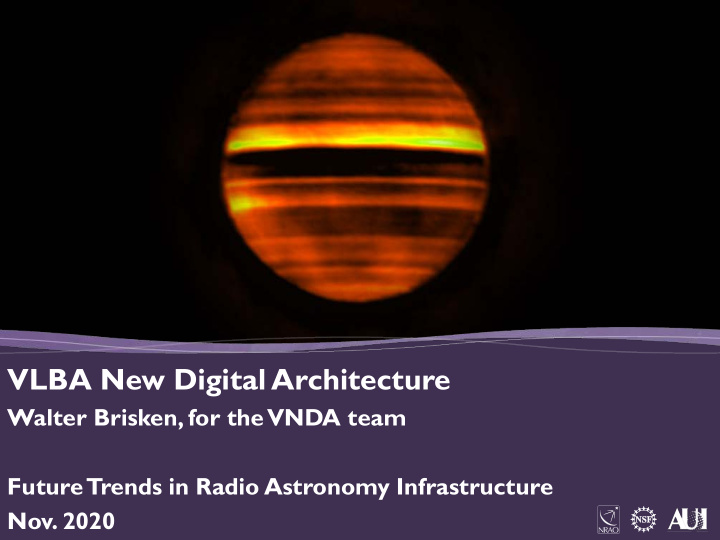



VLBA New Digital Architecture Walter Brisken, for the VNDA team Future Trends in Radio Astronomy Infrastructure Nov. 2020 Future Trends in Radio Astronomy Instrumentation 1
VLBA New Digital Architecture (VNDA) • Project to replace the aging ROACH DBEs – Sample data – Channelize and quantize for VLBI processing – Time-tag and format – Demodulate “continuous cal” switched power Future Trends in Radio Astronomy Instrumentation 2
Requirements and design goals • Backwards compatible with existing VLBA capabilities • Provide gateway to higher bandwidths • Support for 2, 4, or 8 (maybe 12) bits per sample • Timing stability at sample level (no jumps) • Support for non-VLBI use o E.g., pulsars, spectroscopy, transient searches o Some use cases may require user-supplied HW or SW • Improve sustainability o Improved in RFI tolerance and avoidance o Improved compatibility with other VLBI systems o Reduced operations footprint o Increased maintainability Future Trends in Radio Astronomy Instrumentation 3
Engineering Approach • Develop functional (superset) replacement of RDBEs – Stay focused on core functionality – Provide interfaces for future expansion • Replacement system developed to following philosophies o Use commercial off-the-shelf (COTS) hardware where possible o Use standard interfaces and data formats where possible o Self diagnostic capabilities designed in from start o MTBF-informed design o Consider downstream obsolescence o Digitize as close to receivers as possible o Use multicast, to allow flexible re-use of signals Future Trends in Radio Astronomy Instrumentation 4
Project Phases • Phase 1: (Complete) o Risk reduction o Development of design concept o Conceptual design review o Phase 2: (Oct 2020 to Dec 2021*) o Preliminary design o One VLBI baseband mode implemented o Zero baseline test o Preliminary design review * timelines are approximate Future Trends in Radio Astronomy Instrumentation 5
VNDA-Oryx Project Phases • Phase 3: (Jan 2022 to Mar 2023*) o Final design o Deploy 2 units in field o Conduct fringe test o Final design review • Phase 4: (Apr 2023 to Jun 2024*) o Procure and assemble production hardware o Install at all sites o Commissioning / science verification o Offer new capability to users * timelines are approximate Future Trends in Radio Astronomy Instrumentation 6
Major new components • Sampler modules, in receiver cabin o Creates 4 “digital IFs”, 1024 MHz bandwidth, in VDIF format • 100 Gbps network switch o Fabric that connects all signal processing and recording components • Channelizer module o Creates digital baseband channels o Requantizes to 2 (or other) bits per sample o Computes calibration metadata (switched power) • Timing module o Need repeatable 1 PPS tick and clock signals in receiver cabin Future Trends in Radio Astronomy Instrumentation 7
VNDA Data path Future Trends in Radio Astronomy Instrumentation 8
VNDA prototype rack • 100 Gbps Switch – Fiber sources 8500-32c – 32 ports • Sampler (Dell R740) – 2x dual 40Gb NICs – PCI592 w/ sampler module • Channelizer (Dell R740) – PCI592 module – Also GPU • Software dev system – With Xilinx evaluation kit Future Trends in Radio Astronomy Instrumentation 9
Make use of commercial equipment • Commercial Off-The-Shelf (COTS) hardware, firmware and software • Let industry pay for most of the NRE • Buy components with standard interfaces • Upgrade in the future with expectation of compatibility • Some specific commercial offerings follow – VNDA not 100% tied to these solutions – Prototype is based on them Future Trends in Radio Astronomy Instrumentation 10
Future Trends in Radio Astronomy Instrumentation 11
Xillybus • Commercial solution to FPGA CPU communication • Modern Linux kernels have native support • Maps data streams on FPGA to file streams in Linux • Demonstrated on VNDA hardware at nearly full PCIe3 x8 speed – More than sufficient • Supported by a wide array of PCIe FPGA hardware • The company has been very supportive in initial development Future Trends in Radio Astronomy Instrumentation 12
Future Trends in Radio Astronomy Instrumentation 13
Sampler module with standard FMC interface Future Trends in Radio Astronomy Instrumentation 14
Thanks to the VNDA team! • Matt Luce • Alan Erickson • Sylas Ashton • Ephraim Ford • Kristin Renda • Jon Cooper • Jonathan Dooley Future Trends in Radio Astronomy Instrumentation 15
science.nrao.edu public.nrao.edu ngvla.nrao.edu The National Radio Astronomy Observatory is a facility of the National Science Foundation operated under cooperative agreement by Associated Universities, Inc. Future Trends in Radio Astronomy Instrumentation 16
Recommend
More recommend